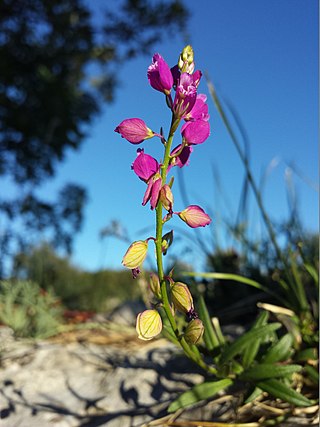
Polygala is a large genus of flowering plants belonging to the family Polygalaceae. They are commonly known as milkworts or snakeroots. The genus is distributed widely throughout much of the world in temperate zones and the tropics. The genus name Polygala comes from the ancient Greek "much milk", as the plant was thought to increase milk yields in cattle.

Chloris virgata is a species of grass known by the common names feather fingergrassfeathery Rhodes-grass and feather windmill grass.

Ficus palmata, the Punjab fig, or "Bedu" is a plant in the family Moraceae. It is native to southern Egypt across to north-eastern tropical Africa and also the Arabian Peninsula. It is a shrub/tree with edible fruit.

Polygala myrtifolia, the myrtle-leaf milkwort, is an evergreen 2-4m tall South African shrub or small tree found along the southern and south-eastern coasts, from near Clanwilliam in the Western Cape to KwaZulu-Natal. It is a fast-growing pioneer plant, a typical fynbos component, and may be found on dunes, rocky places, along forest margins, beside streams, and in open grassland. It belongs to the milkwort family of Polygalaceae.

Polygala comosa is a species of flowering plant in the family Polygalaceae. It is endemic to most of Europe.

Polygala cymosa, the tall pinebarren milkwort, is a species of flowering plant in the family Polygalaceae. It is endemic to the United States.

Polygala fruticosa is a species of flowering plant in the milkwort family (Polygalaceae). It is native to Eswatini and Kwazulu-Natal and the Cape Provinces in South Africa. It was first described by Peter Jonas Bergius in 1767. According to the Red List of South African Plants, it is of least ecological concern.
Polygala hookeri is a species of flowering plant in the milkwort family (Polygalaceae). It is endemic to Alabama.

Polygala hottentotta is a species of flowering plant in the milkwort family (Polygalaceae). It is native to South Africa, Namibia, Lesotho, Mozambique, Eswatini, and Zimbabwe.

Polygala nicaeensis is a species of flowering plant in the milkwort family (Polygalaceae). It is native to France and Italy.

Polygala paniculata is a species of flowering plant in the milkwort family (Polygalaceae). It is native to grasslands with altitudes between 350 and 1,700 metres. It is native to Central and South America and has been introduced to East Africa, South Asia, and Southeast Asia. It is an annual herb which has a height between 15 and 50 centimetres It is used as a medicine against snake bites and blenorrhagias. The flowers of the plant have been described as pink or white.

Polygala persicariifolia is a species of flowering plant in the milkwort family (Polygalaceae). It is native to east Africa and Asia.

Polygala rehmannii is a species of flowering plant in the milkwort family (Polygalaceae). It is endemic to areas with an altitude below 1,160 metres (3,810 ft) in Southern Africa. It was first described by Robert Chodat in 1893.
Polygala sekhukhuniensis is a species of flowering plant in the milkwort family (Polygalaceae). It is endemic to South Africa.

Polygala serpentaria is a species of flowering plant in the milkwort family (Polygalaceae). It is native to South Africa and Eswatini.

Polygala umbellata is a species of flowering plant in the milkwort family (Polygalaceae). It is endemic to the Cape Provinces of South Africa.
Polygala westii is a very rare plant species in the family Polygalaceae. It is an annual herb which is 10 to 12 centimetres tall and it produces green flowers. It is endemic to southern Africa.
Polygala xanthina is a plant species in the family Polygalaceae. It is an annual herb which has a height of between 30 and 50 centimetres. The colour of its flowers have been described as greenish purple, bluish, yellowish, or pinkish. It is endemic to grasslands, woodlands, and seasonal swamps in Tropical Africa within altitudes between 1,000 and 1,800 metres.
Polygala irregularis is a species of flowering plant in the family Polygalaceae. It is a perennial herb with a height up to 60 centimetres (24 in), though the average ranges from 17 to 34 centimetres. It produces lilac to reddish-brown flowers. It is native to grasslands and sandy areas of Northern Africa, the Middle East, and South Asia with altitudes below 500 metres (1,600 ft).
Polygala multiflora is a plant species in the milkwort family (Polygalaceae). It is native to Western Africa. It is an erect plant and is considered to be "probably 2 to 3 feet " though it can grow up to 6 feet (1.8 m) tall. Its stems are puberlouous and its leaves are 2 to 3 inches long and 1⁄6 inch (0.42 cm) wide. The flowers it produces are blue or purple. It was first written about was part of the Encyclopédie méthodique Botanique in 1804 by Jean Louis Marie Poiret.














